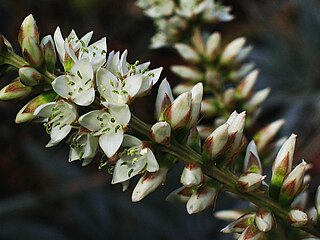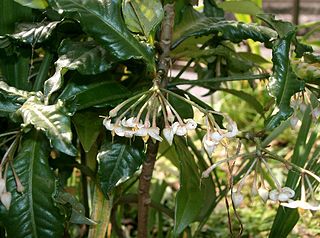
The Bromeliaceae is a family of monocot flowering plants of 75 genera and around 3590 known species native mainly to the tropical Americas, with a few species found in the American subtropics and one in tropical west Africa, Pitcairnia feliciana.

The Primulaceae, commonly known as the primrose family, are a family of herbaceous and woody flowering plants including some favorite garden plants and wildflowers. Most are perennial though some species, such as scarlet pimpernel, are annuals. It includes the former families Myrsinaceae, Theophrastaceae and Maesaceae.

Puya is a genus of the botanical family Bromeliaceae. It is the sole genus of the subfamily Puyoideae, and is composed of 226 species. These terrestrial plants are native to the Andes Mountains of South America and southern Central America. Many of the species are monocarpic, with the parent plant dying after one flower and seed production event.

Hechtia is a genus of plants in the family Bromeliaceae, and is the sole genus of the subfamily Hechtioideae, containing 75 species. Its species are native to Mexico, Central America, and Texas.

Bromelia is the type genus of the plant family Bromeliaceae, subfamily Bromelioideae. Bromelia species are widespread across much of Latin America and the West Indies, and are characterized by flowers with a deeply cleft calyx. The genus is named after the Swedish medical doctor and botanist Olof Bromelius (1639-1705).

Vriesea is a genus of flowering plants in the botanical family Bromeliaceae, subfamily Tillandsioideae. The genus name is for Willem Hendrik de Vriese, Dutch botanist, physician (1806–1862). Its species are widespread over Mexico, Central America, South America and the West Indies.

Aechmea is a genus of flowering plants in the family Bromeliaceae. The name comes from the Greek aichme, meaning "spear". Aechmea comprises eight subgenera and around 250 species distributed from Mexico through South America and the Caribbean. Most of the species in this genus are epiphytes.

Billbergia is a genus of flowering plants in the family Bromeliaceae, subfamily Bromelioideae. The genus, named for the Swedish botanist, zoologist, and anatomist Gustaf Johan Billberg, is divided into two subgenera: Billbergia and Helicodea. They are native to forest and scrub, up to an altitude of 1,700 m (5,577 ft), in southern Mexico, the West Indies, Central America and South America, with many species endemic to Brazil.

Ardisia is a genus of flowering plants in the family Primulaceae. It was in the former Myrsinaceae family now recognised as the myrsine sub-family Myrsinoideae. They are distributed in the Americas, Asia, Australia, and the Pacific Islands, mainly in the tropics. There are over 700 accepted species. One species, Ardisia japonica is one of the 50 fundamental herbs in traditional Chinese medicine.

Dyckia is a genus of plants in the family Bromeliaceae, subfamily Pitcairnioideae.

Pitcairnia is a genus of plants in the family Bromeliaceae, subfamily Pitcairnioideae. It was named for Dr. William Pitcairn, Scottish physician and gardener (1711–1791). The genus Pitcairnia ranks as the second most prolific of the bromeliad family. They are most abundant in Colombia, Peru and Brazil, but can also be found in areas from Cuba and Mexico south to Argentina. One species, Pitcairnia feliciana is found in tropical West Africa and is the only member of the family Bromeliaceae not native to the Americas.

Orthophytum is a genus in the plant family Bromeliaceae, subfamily Bromelioideae.

Hohenbergia is a genus of plants in the family Bromeliaceae, subfamily Bromelioideae. It is native to the West Indies, the Yucatán Peninsula, and northern South America.

Greigia is a genus of plants in the family Bromeliaceae, subfamily Bromelioideae. It is native to Latin America from Mexico to Chile. The genus is named in honour of Major General Samuel Alexjewitsch Greig, president of the Russian Horticultural Society in 1865.

Rapanea is a genus of plant in family Primulaceae. It has often been placed in synonymy with Myrsine, and many species have been moved to Myrsine.
Amblyanthopsis bhotanica is a species of flowering plant in the primrose family (Primulaceae). It is native to Bhutan.
Oncostemum are a genus of flowering plants in the family Primulaceae, native to the Comoros and Madagascar. The Mascarene Islands endemic genus Badula appears to nest inside Oncostemum.
Loheria is a genus of flowering plants belonging to the family Primulaceae.
Barfussia is a genus of flowering plants belonging to the family Bromeliaceae.














